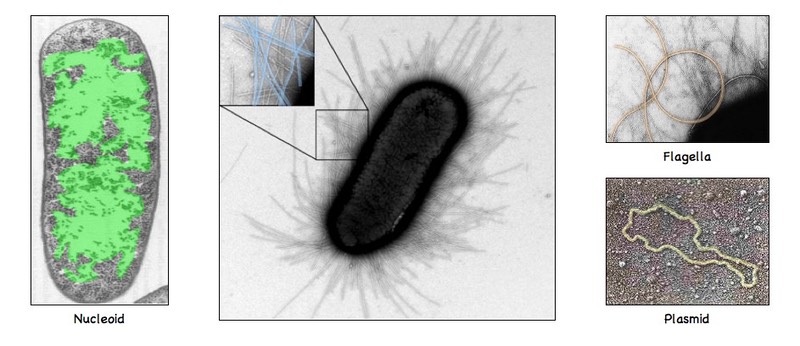2.2.1 Draw and label a diagram of the ultrastructure of Escherichia coli (E. coli) as an example of a prokaryote
2D Representation 3D Representation

2.2.2 Annotate the diagram with the function of each of the named structures
Cell Wall: A rigid outer layer made of peptidoglycan that maintains shape and protects the cell from damage or bursting if internal pressure is high
Cell Membrane: Semi-permeable barrier that controls the entry and exit of substances
Cytoplasm: Fluid component which contains the enzymes needed for all metabolic reactions
Nucleoid: Region of the cytoplasm which contains the genophore (the prokaryotic DNA)
Plasmid: Additional DNA molecule that can exist and replicate independently of the genophore - it can be transmitted between bacterial species
Ribosome: Complexes of RNA and protein that are responsible for polypeptide synthesis (prokaryotic ribosomes are smaller than eukaryotes - 70S)
Slime Capsule: A thick polysaccharide layer used for protection against dessication (drying out) and phagocytosis
Flagella (singular flagellum): Long, slender projection containing a motor protein which spins the flagella like a propellor, enabling movement
Pili (singular pilus): Hair-like extensions found on bacteria which can serve one of two roles
- Attachment pili: Shorter in length, they allow bacteria to adhere to one another or to available surfaces
- Sex pili: Longer in length, they allow for the exchange of genetic material (plasmids) via a process called bacterial conjugation
2.2.3 Identify structures from 2.2.1 in electron micrographs of E. coli
Electron Micrograph of Escherichia coli

2.2.4 State that bacterial cells divide by binary fission
Binary fission is a form of asexual reproduction and cell division used by prokaryotic organisms
It is not the same as mitosis, there is no condensation of genetic material and no spindle formation
In the process of binary fission:
- The circular DNA is copied in response to a replication signal
- The two DNA loops attach to the membrane
- The membrane elongates and pinches off (cytokinesis) forming two separate cells
The Process of Binary Fission
